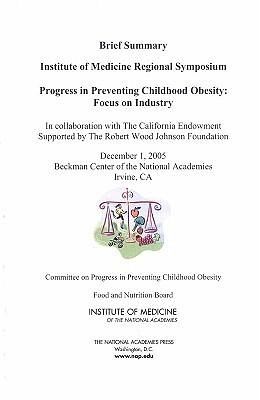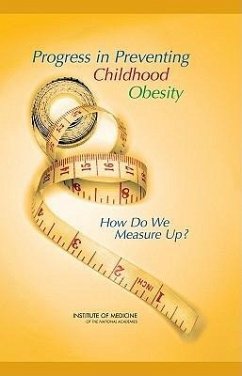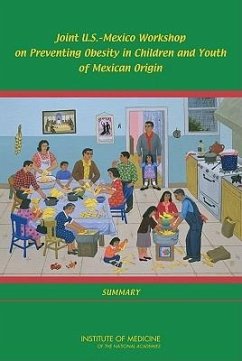
Progress in Preventing Childhood Obesity
Focus on Industry - Brief Summary: Institute of Medicine Regional Symposium
Versandkostenfrei!
Versandfertig in über 4 Wochen
20,99 €
inkl. MwSt.

PAYBACK Punkte
10 °P sammeln!
In 2002, Congress charged the Institute of Medicine (IOM) with developing a prevention-focused action plan to reduce the number of obese children and youth in the United States. In 2005, with support from The Robert Wood Johnson Foundation (RWJF), the IOM is building on its previous work by conducting a study to assess progress toward the obesity prevention recommendations in the original report. The IOM organized three regional meetings in the midwest, southeastern, and western United States to galvanize obesity prevention efforts of local, state, and national decision-makers, community and s...
In 2002, Congress charged the Institute of Medicine (IOM) with developing a prevention-focused action plan to reduce the number of obese children and youth in the United States. In 2005, with support from The Robert Wood Johnson Foundation (RWJF), the IOM is building on its previous work by conducting a study to assess progress toward the obesity prevention recommendations in the original report. The IOM organized three regional meetings in the midwest, southeastern, and western United States to galvanize obesity prevention efforts of local, state, and national decision-makers, community and school leaders, grassroots organizations, and industry representatives including the food, beverage, restaurant, leisure, recreation, and entertainment industries. These three meetings will involve disseminating the findings and recommendations of the original IOM report and catalyzing dialogues that highlight best practices and identify assets and barriers to moving forward with obesity prevention efforts in each selected region. In collaboration with The California Endowment, the committee held its third regional symposium on December 1, 2005 in Irvine, California. The symposium included three plenary panels that focused on food and physical activity products, portfolio shifts, and packaging innovations; retailing healthy lifestyles with regard to food and physical activity; and the business response to childhood obesity. Participants also engaged in two break-out sessions. The first session focused on marketing communication strategies that promote both healthful products and physical activity opportunities. The second session focused on public and private education campaigns and industry self-regulation of advertising to children. A program agenda is at the end of this summary. The symposium provided a useful forum for stakeholders to explore viable strategies and exchange information about promising practices for addressing barriers to obesity prevention initiatives, and to identify how public health interests can coincide with the business interests of companies to have a positive impact on reversing the childhood obesity trend. This summary highlights the recurring themes for accelerating change and how industry collectively can move forward with obesity prevention efforts that emerged from the symposium. The themes include reverse the obesity trend; market health and nutrition; make a business commitment to health; change the food and physical activity environment; forge strategic partnerships; garner political support to ally public health and industry; educate stakeholders; collect, disseminate, and share local data; and evaluate programs and interventions. This summary, along with those of two other symposia summaries and a more detailed discussion of insights and regional examples, will be incorporated in the IOM committee's final report on progress in preventing childhood obesity that will be released in the fall of 2006.












